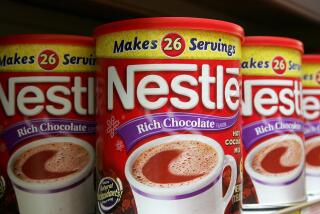Get Your Chocolate ‘Fix’ Without Fudging on Diet
- Share via
During any day, Howard Levin’s “fix” isn’t far from his side. Waiting in his desk drawer are chocolate goodies, including chocolate-covered granola bars and miniature candy bars he keeps “for emergencies.”
The founder of the Laguna Beach-based Chocolate Lovers of America says his chocolate fixation is nothing out of the ordinary.
“There are many chocoholics out there who are finally starting to come out of the pantry, so to speak,” says Levin, who heads the 265-member national organization he founded in 1981.
“We define a chocoholic as someone who will gratefully accept a box of chocolate from the giver and then immediately put it away without sharing any,” he says.
“There is no doubt that chocolate is one of the most universally liked flavors in the world,” agrees Paul Dimick, a professor of food science at Pennsylvania State University, where research on chocolate and cocoa has been conducted for 30 years.
“Chocolate is not something we consume because of it’s nutritional value,” says Dimick. “Generally, we eat chocolate because of its pleasant, incomparable flavor.”
Besides its unique taste, there are a few other reasons why many people relish chocolate, says Fountain Valley registered dietitian Annette Globits, who provides nutritional consultations and regularly speaks to businesses and community groups. One lecture is titled “Chocolate is Not a Sin.”
“Food texture has a lot to do with food enjoyment. The main reason people savor chocolate candy is the ever-changing oral sensation it causes in the mouth as it melts,” says Globits. “Many also like chocolate because of the added fat and sugar. Without these ingredients, it would be grainy and bitter.”
Our love affair with chocolate is by no means new. “Chocolate was first consumed as a beverage in South America during the time of the Mayas and Aztecs,” says Globits. “The Aztec king Montezuma drank a very thick cold unsweetened chocolate drink before visiting his wives, which is where chocolate got its unfounded aphrodisiac reputation.”
In the United States, apothecaries originally sold chocolate as a medicinal health-preserving drink. Then in 1894, the cocoa manufacturer, Milton Hershey, launched the first candy bar. By 1903, he had built the first chocolate factory.
Despite its many good points, chocolate has one major drawback: it’s generally high in fat. A 1 1/2-ounce milk chocolate bar has about 14 grams of fat, or the same amount you would find in 1 1/2 ounces of aged Cheddar cheese and five ounces of cooked and trimmed filet mignon, says Globits.
The good news is, it’s not necessary to quit eating chocolate. You can fit chocolate into a healthy lifestyle by keeping the following tips in mind.
Try chocolate in moderation
“If you’re eating an overall healthy diet, it’s perfectly acceptable to indulge in small amounts of chocolate,” says Globits, who notes that while boxed candy sales have decreased in the last several years, manufacturers are now selling more individual candies.
Instead of eating a whole candy bar, try eating one or two chocolate kisses or other small chocolate pieces, she says. One kiss has just 1.4 grams of fat and 25 calories.
When you do eat chocolate, take time to really enjoy it, says Globits. “Don’t do anything else; just sit back, close your eyes and savor every morsel.”
Levin, who eats a small amount of chocolate every day, agrees. “Instead of feeling guilty about chocolate and sneaking it, we encourage people to enjoy a little every day. This ensures that you feel satisfied and not deprived.”
So that chocolate doesn’t take a toll on the body, Levin’s organization advises its members to eat chocolate before three in the afternoon and to exercise. Their philosophy seems to work.
“Many of our members eat a little chocolate on a daily basis, and very few of us have a weight problem,” he says.
Seek out low-fat alternatives
If you have difficulty sticking to just a few candy kisses, you may want to try some of the many new low-fat chocolate products on the market.
Two major candy companies have released candy bars made of caprenine, a lower-calorie fat made of dehenic acid, which is only partially absorbed by the body.
Also, keep an eye out for lower-fat cookies and cakes. One major brand has chocolate cookies which have just one gram of fat each. Other possibilities are fat-free chocolate pastries, although watch the calorie content--they tend to be very high in sugar.
For the person who wants a hot fudge sundae, there are reduced-fat and even nonfat fudge sauces in grocery stores. For a nonfat fudge sauce that also has no sugar and is sweetened with concentrated fruit juice, try a health food store or gourmet deli.
Globits suggests using the fudge sauce to top nonfat frozen yogurt or one of the fat-free frozen desserts on the market that contain Simplesse, a fat substitute made of finely spun egg whites and nonfat milk protein.
Carob as an alternative
Although carob is considered a chocolate substitute, it has a very different flavor from chocolate and some carob products are also high in fat.
Carob is, however, an alternative for those allergic to chocolate or susceptible to migraine headaches, says Globits.
“‘People who suffer from migraines may lack sufficient monoamine oxidase, which is an enzyme needed to break down the phenylethylamine in chocolate. If phenylethylamine increases in the blood stream, it will raise blood pressure and may result in a migraine. So if you get migraines, go easy on the chocolate,” she says.
Lowering fat in treats
It’s possible to make your own low-fat chocolate desserts by substituting lower-fat cocoa for chocolate. “One ounce of Hershey’s unsweetened chocolate has 16 grams of fat, while 1/3 cup of cocoa has only four grams of fat,” says Globits.
Because you remove fat from a recipe when you substitute cocoa for chocolate, it’s important to add something that will help retain moisture, says Globits. “Putting dark corn syrup in recipes helps keep the baked items moist and tasting chocolatey. For each three tablespoons of cocoa in a recipe, use one tablespoon of dark corn syrup. To add an extra chocolate boost, try chocolate extract.”
Another great fat substitute is pureed prunes, which also add fiber. “Prune puree works better than applesauce and other fruit purees as a fat replacer because prunes are high in pectin, which helps to trap air, resulting in light and fluffy baked goods,” says Globits. “Prunes also contain sorbitol, which keeps baked items moist and lengthens their shelf life, and the fruit has malic acid, a natural flavor enhancer.”
For every cup of fat, you can substitute a half cup of pureed prunes. Find canned or jarred prune and prune/plum purees in the kosher section of your local market or use prune baby food.
Low-guilt recipes
Globits has modified a number of recipes to satisfy a chocolate tooth without going overboard. Her version of oatmeal brownie cookies uses corn syrup and each cookie has just a half gram of fat. She uses prunes in a chocolate cake recipe to help cut the fat content from 17 grams per slice to just three. For the die-hard, there is a low-fat frosting.
Oatmeal brownie cookies: In a large bowl, combine 2/3 cup flour; 2/3 cup sugar; 1 cup quick oats; 1/3 cup unsweetened cocoa; 1 teaspoon baking powder and 1/4 teaspoon salt. Add 3 egg whites; 1 teaspoon chocolate extract; 1 ounce melted and cooled unsweetened baking chocolate; 1/3 cup light or dark corn syrup and 1 teaspoon of vanilla. Stir just until dry ingredients are moistened and drop by teaspoonfuls onto a cookie sheet that has been prepared with a vegetable oil spray.
Bake at 350 for 10 minutes, or until cookies set.
*
Chocolate cake: Sift together 2 cups of flour; 1 cup of unsweetened cocoa powder; 2 cups of sugar; 2 teaspoons of baking soda; 1 teaspoon of baking powder and 1/4 teaspoon of salt. Add four 2 1/2-ounce jars of pureed prune baby food; 2 teaspoons of vanilla; 2 beaten eggs; 1 teaspoon chocolate extract; 1 ounce melted and cooled unsweetened baking chocolate and 1 cup of nonfat milk. Stir just until blended. Combine 2 tablespoons instant espresso coffee powder with 1 cup boiling water, stir to dissolve and then stir into batter until blended.
Pour batter into 2 (9-inch) round baking pans prepared with vegetable spray. Bake at 350 degrees for 35-45 minutes, or until cakes test done with a toothpick.
*
Low-fat cocoa frosting: In a 1 to 2-quart pan, stir together 2/3 cup sifted unsweetened cocoa and 1/2 cup sugar. In a small bowl, mix 1/3 cup cornstarch and 1 cup nonfat milk until well blended and add to pan. Cook mixture over medium heat, stirring constantly and scraping the pan bottom and sides with a whisk, until glossy and thick, about 7 minutes. Remove pan from heat, add 1/4 teaspoon of vanilla and beat to remove lumps.
Cool completely; stirring occasionally. If chilled before using, bring to room temperature and beat until smooth.
More to Read
Eat your way across L.A.
Get our weekly Tasting Notes newsletter for reviews, news and more.
You may occasionally receive promotional content from the Los Angeles Times.










